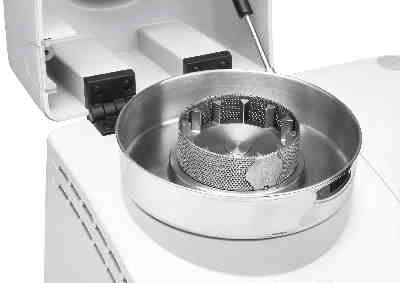In many applications of powder processing, milling or size reduction of solid materials for different purposed is necessary. The main objective of size reduction is to produce smaller particles either for their larger surface or because of their shape, size and number. The final product normally consists of a mixture of particles which may contain a wide variety of sizes and shapes. Therefore, a milling process combined with a sieving screen can also narrow down the particle size distribution.
For size reduction process on solid materials, we make use of equipment with different mixing principles in our field testing area: Our ultra-centrifugal mill effectively reduces the soft to medium-hard and fibrous solid to a well-defined size distribution, which takes place by impact and shearing effects by means of a high-speed rotor mill with ring sieve screens that are present in the actual milling chamber. These sieve screens can be exchanged for shifting the size distribution to lower or larger sizes. This 2-step grinding ensures particularly gentle but fast size reduction processing. The feed material only remains in the milling chamber for a very short time, which means that the characteristic features of the sample to be determined are not altered. The lower particle size range that can be attained is in the order of 40-50 micrometres. The centrifugal mill has a very wide range of applications: bones, cereals, chemical products, coal, coffee beans, collagen, corn, dried fruit and vegetables, dried larvae, drugs, feed pellets, fertilizers, food, minerals, paper, pharmaceutical materials, plant materials, polymers, powder coatings, rubber, spices, sweets, textiles, waste, wood.
For reaching even smaller particle sizes, the different principle of ball milling is used. It is a type of size reduction equipment that works on the principle of impact and attrition. The size reduction occurs by impact as the balls drop and impact the surface of the particles. The ball mill can go down to approx. 10 micrometres in size although it should be noted that this ball mill methodology is most effective with relatively small sample sizes.
The ball mill is used for size reduction process on materials such as coal, pigments and clay. The milling process can be carried out either wet or dry but the wet process is performed at low speed. For systems with multiple components, ball milling has been shown to be effective in increasing solid-state chemical reactivity. Ball milling has also shown its application for the production of amorphous materials.
For milling special materials such as heat-sensitive and tough-to-mill material, cryogenic milling can be applied. Cryogenic milling, also known as freezer milling, freezer grinding, cryogenic grinding and cryo-milling, is the act of cooling or chilling a material and then reducing it into a smaller particle size. For example, cocoa nibs are difficult to be grinded to powdery form at ambient temperatures because they melt into lumpy masses and become sticky. When chilled by dry ice or liquid nitrogen, the cocoa nibs can be nicely grinded into powders suitable for other powder processes.
When selecting a suitable laboratory equipment for cryogenic grinding, various aspects need to be considered, such as: sample volume, dozing size and desired particles size. Our system used liquid nitrogen (–196 °C) to cool down the feed material prior to and during milling to help prevent either melting, decomposition or embrittlement. Cryogenic milling is widely used in food/beverage, pharmaceuticals industries.
During the various size reduction procedures, particle size analysis can be used to confirm the effectiveness of the size reduction procedure by measuring the particle size distribution and verify whether the desired size has been reached.




